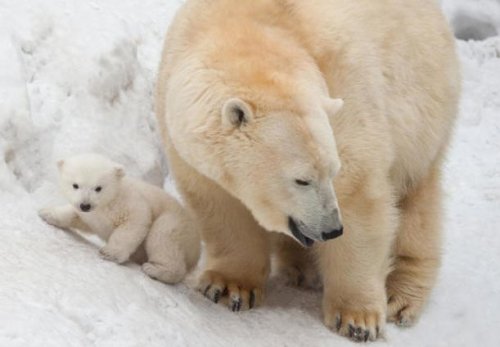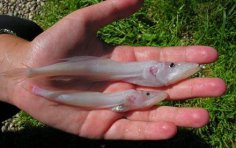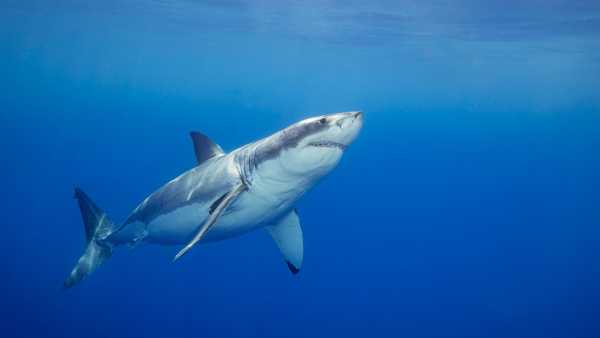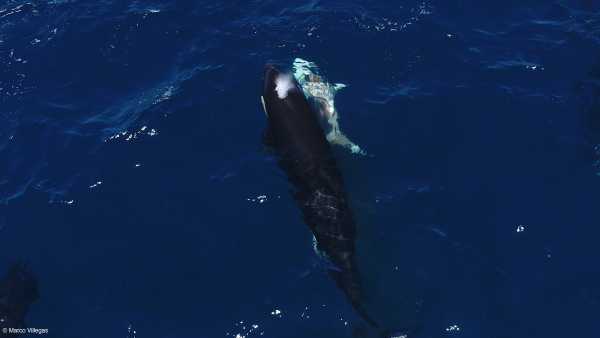
The polar bear is one of the symbols of the 2014 Sochi Olympics, and is also known as umka, which means “adult male polar bear” in Chukchi. Just one little word known to everyone, but so many concepts. In general, this animal has many definitions in addition to the word “bear” – white, polar, northern, sea. But the most correct is the last one, this is what it is called according to Linnaeus' classification – Ursus maritimus, which means – sea bear.
According to science, the polar bear evolved from the brown bear about 600 thousand years ago. It is the largest predator on earth, and really, who else can weigh up to a ton and be up to three meters long? True, such giants are very rare, but even a 2.5-meter specimen is impressive. Females are much smaller, but it is still better not to meet them.
It is interesting that the polar bear's appearance has undergone the greatest changes in the process of evolution. Its skin has become black, and its hairs are colorless and hollow. The translucent hairs have heat-insulating properties, since they only let in ultraviolet rays, so it appears black when photographed under ultraviolet light. The soles of its paws are covered with stiff hair, the best way to avoid slipping on ice and freezing. The toes are connected by a webbing, and its powerful claws allow it to hold even large and strong prey.
The polar bear usually lives on the edge of drifting sea ice, where it hunts its main prey: seals and other sea animals. It catches them by sneaking up from behind shelters or near holes: as soon as the animal sticks its head out of the water, the bear stuns the prey with a blow of its paw and pulls it out onto the ice. Sometimes it overturns an ice floe from below, on which seals are located.
Polar bears are excellent swimmers and divers. Distance is no obstacle for them, often sailors and pilots have encountered these animals in the open sea at a distance of more than a hundred kilometers from the shore or ice floes. At the same time, the speed of a swimming bear is no more than 5-6 kilometers per hour, imagine how much time it must spend in the water. When hunting fish or sneaking up underwater to seals resting on ice floes, the bear dives and swims under water, and can stay there for up to two minutes. When diving, the bear squeezes its nostrils and ear holes and literally rushes underwater with open eyes, driving fish into cracks in rocks and ice. Very thick, dense fur protects the bear's body from the cold and getting wet in icy water.
The polar bear makes seasonal migrations in accordance with the annual changes in the polar ice caps: in summer it retreats with them closer to the pole, in winter it moves south, entering the continent. In winter, pregnant females mainly hibernate for 50-80 days. Males and single females hibernate for a short period and not every year.
Bears are solitary animals. As a rule, they are peaceful towards each other. They live throughout the Arctic space, but their true homeland is small mountainous islands, usually deserted, but always located on the routes of annual bear migrations.
In October, pregnant females dig a den in coastal snow drifts. Female bears have favorite places where they gather en masse to give birth – for example, Wrangel Island or Franz Josef Land, where there are 150-200 dens annually. The entire pregnancy period is 230-250 days; the cubs are born in the middle or end of the Arctic winter. The female remains in hibernation until April.
The female gives birth to her first cubs at the age of 4-8 years, gives birth once every 2-3 years and has 1-3 cubs in a litter, thus giving birth to no more than 10-15 cubs during her life. Cubs are usually born in December-January. It is amazing, but such a huge mother gives birth to cubs covered with sparse whitish fur, deaf and blind, and no larger in size than newborn kittens. This is how nature created them, and the reason for this is obvious: after all, the mother does not eat anything all winter and lives only at the expense of the reserves accumulated over the summer, but if they were larger, she would not be able to feed them. After all, as long as the cubs live with their mother in the den, they feed exclusively on their mother's milk. A female bear's milk is like cream, just as thick and fatty. Only when the mother bear emerges from her snowy den in the spring and begins to hunt do the cubs first try seal meat or fish, although their mother feeds them milk until they are one and a half years old.
Bears continue to grow for several years, with females finishing their growth by the age of five, and males growing for up to eight years. They also reach sexual maturity much later than other animals, so the growth in the bear family is slow, which is compensated only by their longevity: their life expectancy is about 25-30 years, although some bears live up to 40 years.
It is known from literature that polar bears regularly reach the North Pole, and even females with small cubs are found there.
Once, during a trip on a nuclear icebreaker to the North Pole, we had a chance to look at one of these vagabonds to our heart's content. The ship was already returning to Murmansk, and a couple of hundred kilometers from the pole, the ship's radio network announced in a dozen languages, which is how many countries were represented on the ship by their citizens:
– Bear!
A huge white beast appeared in the distance, then came closer and walked parallel to the ship. All the passengers gathered along the side, dozens of people stood on all the decks, everyone wanted to look at this giant.
The beast walked at a leisurely pace, its head hanging low and swinging slightly from side to side. The icebreaker slowed down and was moving at a speed of just over two knots, which, converted into a more understandable language, meant about four kilometers per hour.
On the way he came across a small ropak, that is, a snowy hill, the bear briskly climbed it and stopped, as if thinking about what to do next. It seemed so to us, but in fact he was sniffing and examining the surroundings, whether prey had appeared somewhere.
Then either he got tired of walking next to the ship, or according to the plan he had to go in the other direction, but he turned left and again began to move away, jumping over cracks. Having already gone some distance, he turned his head in our direction and roared loudly, probably as a sign of farewell.





